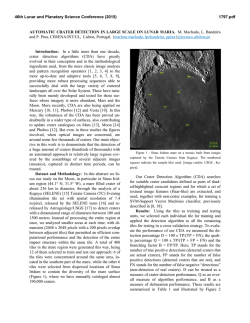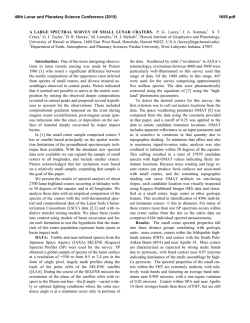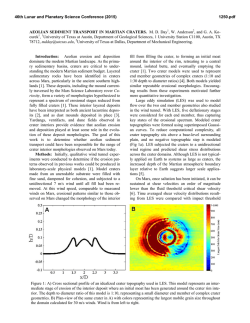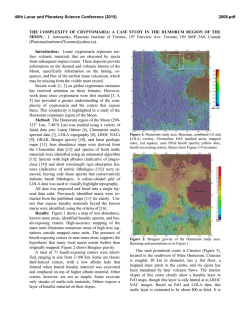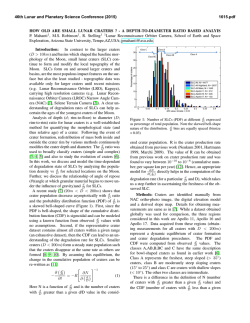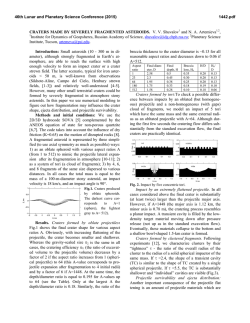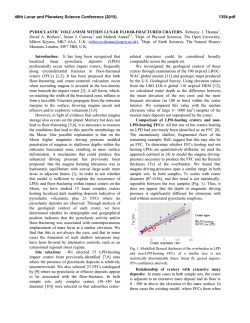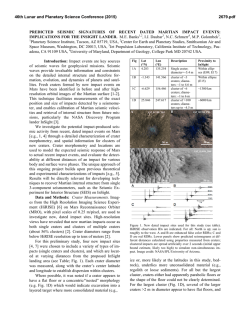
Testing for the Influence of Insolation on Formation and Growth of
46th Lunar and Planetary Science Conference (2015) 1489.pdf TESTING FOR THE INFLUENCE OF INSOLATION ON FORMATION AND GROWTH OF HOLLOWS ON MERCURY. E. M. Molter1 and C. M. Dundas2, 1Macalester College, 1600 Grand Ave., Saint Paul, MN 55105 ([email protected]), 2U. S. Geological Survey, 2255 N. Gemini Dr., Flagstaff, AZ 86001 ([email protected]). !! ! Introduction: Hollows are fresh-appearing, irregular, shallow (mean depth ∼47m [1]), flat-bottomed, rimless depressions with diameters ranging from tens of meters to a few kilometers [2]. Rocks hosting hollows are usually found on the floors, walls, or central peaks of impact craters of all sizes and ages [1,3]; however, some hollows are found far from craters. Hollows are widespread across the surface in low-albedo materials [3,4]. The steep sides, sharp angles, and lack of superimposed impact craters imply that hollows are relatively young, and may still be forming or growing [2]. The mechanism governing their formation, however, remains unknown. Volcanism, once a widespread process on Mercury [5], created irregular depressions such as pit craters, calderas, and pyroclastic vents on the planet's surface. However, these features are generally larger than hollows, with sloping floors and a much redder color [6,7]. Hollows are more likely to form from volatile deposits similar to those that form the Martian "Swiss cheese" terrain [e.g., 8]. The link between hollows and impact craters suggests that hollow-forming material may be exhumed from depth and exposed to an extremely low-pressure, high-temperature environment. Such a drastic environmental change could cause volatiles sequestered in the material to become unstable, sublime, and escape to space, leaving behind a collapse pit [2]. Alternatively, a substance present in the exhumed material may be susceptible to space weathering [2]. If the release of volatiles is temperature-dependent, a link between insolation intensity and occurrence of hollows is expected. Previous studies have found a weak correlation between solar exposure and hollow formation [1,3]. They observe that the total area covered in hollow material, if binned by longitude, peaks around 0o and 180o, the longitudes of Mercury's "hot poles”; however, a large unexplained anomaly exists at -50o E [1]. Binned by latitude, a strong peak is found between 0o and 30o, but this may be attributable to observational bias. Some evidence has also been found that hollows form preferentially on sun-facing slopes. In many locations hollows appear on slopes that experience maximal solar heating [3]. In fact, where hollow sites display a preferred slope aspect, the correlation between hollow formation and insolation is fairly strong [1]. However, only 8% of sites in that study were found to have a clear preferred aspect, and since many hollows are found on flat surfaces or in groups containing individuals on slopes with opposing aspects, [1] concluded that preferential formation on sun-facing slopes is not common to all hollows. In this abstract we carry out a quantitative, global investigation of whether hollow formation is primarily driven by insolation-induced processes. Methods: We analyzed all PDS-released (as of June 2014) MESSENGER Mercury Dual Imaging System Narrow Angle Camera (MDIS-NAC) images with a resolution better than 40 m/px and within ±1 degree latitude and longitude of the hollow sites identified by Blewett et al. [3]. The selected images were projected using the USGS's Map Projection On the Web (POW; astrocloud.wr.usgs.gov) tool, which performs standard image reduction and projection algorithms derived from the USGS's ISIS (Integrated Software for Imagers and Spectrometers; isis.astrogeology.usgs.gov) software. The projected images were loaded into ArcMap GIS software for analysis. We searched every image in the dataset for hollows and categorized them by morphology. The first category, ellipses, includes morphologically simple, roughly elliptical hollows occurring on flat-appearing surfaces. The second category, chains, includes groups of two to four linked elliptical hollows on flat ground for which a single linking direction can be determined. The third category, rim hollows, includes hollows occurring along the walls and rims of impact craters. Craters partially covered by shadows were excluded, since it was impossible to determine whether hollows were present on the shaded side. Morphologically complex hollows, hollows occurring on slopes not associated with crater rims, hollows too small or unclear to allow an accurate categorization, and hollows that could not be distinguished from craters or volcanic features were not marked. We used ArcMap to extract the azimuth angle of the lines and ellipse major axes, as well as the range of angles along crater rims subtended by hollows. Results: Our dataset consisted of 316 roughly elliptical hollows, 626 chains of hollows, and 160 craters with rim hollows. Rose diagrams displaying azimuth information for the ellipses and crater rims are shown in Figures 1 and 2 respectively. All three categories display a mean orientation along the northwest-southeast axis, with values of 174o for the ellipses, 149o for the chains, and 306o for the crater hollows, where 46th Lunar and Planetary Science Conference (2015) 0o is north. Although we attempted to create a dataset covering the entire northern hemisphere, the images that fit our selection criteria were grouped strongly by longitude. For example, more than half of the chains (330/626) fell between -90o and -45o longitude, a strong anomaly that matches the one found by Thomas et al. [1] near -50o longitude. Almost no data were collected between -180o and -90o or between -45o and 90o. These large inhomogeneities mean that the data do not necessarily represent global trends and that regional conditions may have an important effect. Figure 1. Major axis orientation angles of elliptical hollows. Original data ranged from 0o to 180o but was mirrored for better visual representation. 1489.pdf ny crater walls and, when forming on flat ground, growing preferentially on their sunny sides. Since Mercury's axial tilt is almost zero, south-facing slopes in the entire northern hemisphere receive more sun than north-facing slopes, leading to the prediction that hollows will orient themselves along the north-south axis. Our data show evidence of this; however, the orientation direction is skewed westward from north, especially for the crater rim hollows. Much of our data come from the longitude range -90o to -45o, so regional conditions may affect our data. These longitudes are to the west of Mercury's "hot pole" at 0o, which means that east-facing crater or hollow walls experience a higher maximum temperature and more intense solar heating and weathering than west-facing walls. The westward skew in the data is therefore consistent with a dependence of hollow growth on insolation intensity; however, without more extensive data from other longitudes this cannot be confirmed. Combined with evidence from previous studies [1,3] that hollows weakly prefer sun-facing slopes, our results are overall consistent with the hypothesis that hollows form and grow from insolation-driven escape of volatile materials from Mercury's subsurface in a process reminiscent of the 'Swiss cheese' terrain in the Martian south polar region [8]. As in the case of 'Swiss cheese,' the complex structures of many hollows may arise from the mergers of simple landforms. This finding adds to a growing body of evidence [6,10,11] that Mercury houses more volatiles than predicted by some models for the planet's formation [12,13,14]. ! Figure 2. Angles along impact craters subtended by hollow material. ! Discussion: Our results show a clear preferred orientation for hollows in all three categories: on the northwest side of craters and along a northwest-southeast axis for chains and ellipses. This direction is consistent with hollows forming preferentially on sun- Acknowledgements: EMM was funded by the 2014 Research Experience for Undergraduates program at Northern Arizona University. CMD was funded by Planetary Geology and Geophysics grant NNH14AX97I. We thank Trent Hare for assistance with ArcMap. References: [1] Thomas R. J. et al. (2014) Icarus, 229, 221. [2] Blewett D. T. et al. (2011) Science, 333, 1856. [3] Blewett D. T. et al. (2013) JGR, 118, 1013. [4] Xiao Z. et al. (2013) JGR, 118, 1752. [5] Head J. W. et al. (2007) Space Sci. Rev., 131, 41. [6] Kerber L. et al. (2011) Planet. Space Sci., 59, 1895. [7] Goudge T. A. et al. (2014) JGR, 119, 635. [8] Byrne S. & Ingersoll A. P. (2003) Geophys. Res. Lett., 30, 1696. [9] Head J. W. et al. (2011) Science, 333, 1853. [10] Peplowski P. N. et al. (2011) Science, 333, 1850. [11] Nittler L. R. et al. (2011) Science, 333, 1874. [12] Lewis, J. S. (1973) Ann. Rev. of Phys. Chem., 24, 339. [13] Fegley B. & Cameron A. G. W. (1987) Earth & Planetary Sci. Lett., 82, 207. [14] Benz W. et al. (1988) Icarus, 74, 516.
© Copyright 2025

